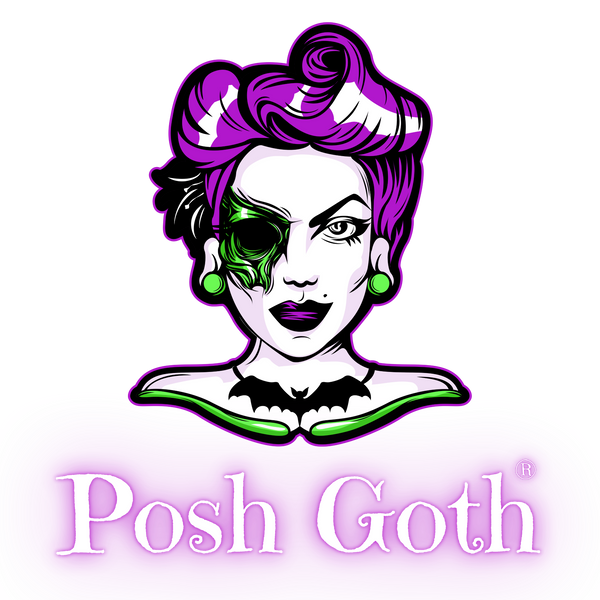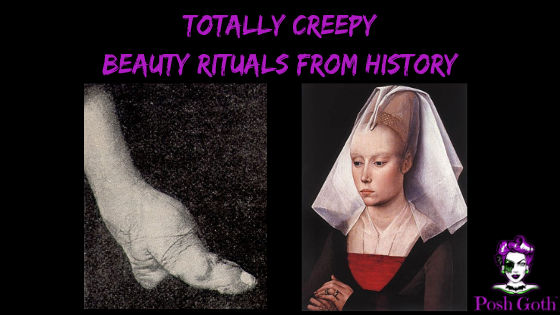
(Posh Goth) - Beauty standards have a long and sordid history. What is considered the golden ratio for beauty today does not even come close to what was standard protocol hundreds (or even thousands) of years ago. Inflated lips in medieval times would have probably gotten a girl hanged, and having eyelashes was an act of blasphemy during the Renaissance.
While today's beauty standards could be considered by some to be equally as disturbing, there were some moments in beauty history that were basically the stuff of nightmares:
Black Tooth Grin (Southeast Asia and Japan)
Say cheese! Teeth lacquering has been practiced for thousands of years by many cultures (primarily Oceanic and Japanese tribes).
In Japan, teeth lacquering was known as Ohaguro, and was a customary rite of passage for aristocratic women after their wedding day. Ferric Acetate, the dye of choice, was formulated by dissolving iron shavings in vinegar. This (probably disgusting) cocktail was then mixed with tea powder to produce the black color. The dye was applied to teeth to prevent decay, and was considered a standard of beauty for hundreds of years.
In 1870, the Japanese government banned ohaguro and the practice eventually went out with the times. However, there are some women who still abide by this practice (namely Geisha's).
 Ukiyo-e of yama-uba with blackened teeth and Kintarō
Ukiyo-e of yama-uba with blackened teeth and Kintarō
Unibrow Wow (Ancient Greece)
Largely considered to be an undesirable feature in modern times, the unibrow was all the wow in Ancient Greece. It was a sign of intelligence and wholesomeness. If a woman lacked a unibrow, she would simply draw one on with some soot she had laying around.
Lotus Feet (China)
Foot binding is probably the most well known (and equally most disturbing) beauty practice from history. It was all the rage by the time the Tang Dynasty rolled around. It was seen as a sign of upper-class and beauty in many parts of ancient China.
When girls reached the age of 5, their already tiny feet were tightly wound in bandages for hours at a time (sometimes for days at a time) in order to prevent the feet from growing along with the rest of the body.
Foot binding was severely disfiguring and permanently disabled many women throughout it's painful history due to the fact that it caused their tiny bones to break repeatedly over many years. It wasn't until the 20th century that this practice began to peter out due to outcries from the government. There are still a reported few number of Chinese women living with lotus feet.
 A photo of a bound foot from 1900
A photo of a bound foot from 1900
Skull So Sexy (Ancient Mayans and some Native American Tribes)
As a mom twice over, one of my fears with both of my babies was that they would develop a flat spot on the back of their skull due to the "back is best" campaign to prevent SIDS. However, the ancient Mayans were all about flat skulls and would begin modifying the shapes of their babies' skulls immediately after birth.
Known officially as artificial cranial deformation, this form of body modification was done by binding the skull between two pieces of wood and was considered a mark of beauty regardless of class or social standing. This practice has been observed not only in Mayan culture, but also in Native American tribes such as the Chinook, and can be traced as far back to Neolithic times.
 Painting by Paul Kane, showing a Chinookan child in the process of having its head flattened, and an adult after the process.
Painting by Paul Kane, showing a Chinookan child in the process of having its head flattened, and an adult after the process.
The Balder the Better (Medieval England)
Forget plucking your eyebrows to frame your face; how about plucking your entire forehead? This is what Medieval European women did to create the look of an elongated face. Eyebrows and eyelashes were also painstakingly plucked away all in the name of beauty. To top off the look, women hid whatever hair was left behind veils and hoods.
 Rogier van der Weyden - Portrait of a Woman
Rogier van der Weyden - Portrait of a Woman
On Her Milk-White Neck, The Devil's Mark (early modern England and colonial New England)
Do you have freckles/and or birthmarks? If so, you would have been considered a witch during the Satanic panic of 1692.
Thought to have been left on an individual after a nocturnal Devil-licking-ritual, visible warts, freckles, or dark marks seen on the skin were basically a bat-signal to the Church that the "Devil was here".
In order to avoid the inevitable punishment of death the befell many of these "witches", women (and men) would lick stones or rub them on their marks to make them fade. They would apply boiled oats and vinegar to the marks to lighten their appearance. And when all else failed, they slopped on some homemade clay plaster to cover them up (kind of like concealer).
While pallor has long been prized to be a gold standard of beauty, the aforementioned practices of covering up marks was not so much a beauty standard as it was a fight for survival.
 Oil painting "Examination of a witch" by Tompkins Harrison Matteson (1853)
Oil painting "Examination of a witch" by Tompkins Harrison Matteson (1853)
Also check out this Posh Goth blog post: The Top Five Most Tragically Goth Figures in History

